Even small voltage surges or transient spikes can cause serious damage to sensitive electronic devices such as computers, phones, fax machines, TVs, audio systems, and other household appliances. As the use of integrated circuits becomes more widespread, the need for effective surge protection has increased significantly due to these components’ high sensitivity to voltage fluctuations. Installing a power surge protector is essential to ensure the safety and longevity of your equipment.
1. Choosing the Right Surge Current Capacity
Understanding lightning protection zones (LPZs) is crucial when selecting surge protectors. The LPZOA area is exposed to direct lightning strikes, so all objects here may conduct lightning current, with no attenuation of the electromagnetic field. In the LPZOB area, objects are not directly struck by lightning, but the electromagnetic field remains strong. The LPZ1 area is further protected, where lightning currents are reduced, and the electromagnetic field may be attenuated based on shielding measures. For even greater protection, the LPZ2 (subsequent zone) should be considered depending on the system requirements.
The selection of surge current capacity should follow national standards like GB50057-94, which specify the required protection levels for buildings. For example, in the LPZOA area, a 10/350μs waveform is used to handle large energy discharges from lightning strikes.
2. Selecting the Maximum Continuous Operating Voltage (Uc)
The maximum continuous operating voltage (Uc) is a key factor in determining the stability of a surge arrester. It must be chosen carefully, considering normal grid fluctuations and potential fault voltages. In TT AC systems, the phase-to-ground voltage can reach up to 1.5 times the nominal voltage (e.g., 330Vrms for 220V). Therefore, in unstable environments, it’s recommended to choose a surge protector with a Uc of at least 385Vrms.
In DC systems, the ratio of Uc to the normal operating voltage typically ranges between 1.5 and 2 times, depending on the application.
3. Evaluating Residual Voltage (Ures)
While lower residual voltage is generally better, it’s important to consider the test conditions. Residual voltage is usually measured at 20kA (8/20μs) for comparison. A lower residual voltage often correlates with a lower Uc, which may reduce the arrester’s ability to withstand prolonged overvoltage events. Striking a balance between Uc and Ures is essential. Based on experience, a residual voltage below 2kV (at 20kA, 8/20μs) is sufficient for most applications.
4. Alarm Function Selection
To monitor the performance of the surge arrester, an alarm function is necessary. When the arrester fails, the user should be alerted immediately. TOWE offers three alarm options: sound and light alarms for manned environments, remote signal alarms for unattended settings, and advanced models that also detect power failure and phase loss for enhanced monitoring.
5. Adding Backup Protection with Air Switches
For electrical safety, any component connected in parallel with the power supply should have a short-circuit protection device, such as an air switch or fuse, to prevent damage in case of failure.
6. Special Design for Poor Power Environments – 3+1 Structure
In areas with unstable power supplies, using a 3+1 surge arrester structure is recommended. This design includes a varistor module between the phase and neutral lines, and a discharge gap module between the neutral and ground lines. This setup provides more reliable protection than traditional phase-to-ground configurations, especially in TT systems where grounding resistance may be high.
If the neutral line is disconnected or the system experiences phase drift, the fault voltage may exceed the arrester’s Uc, causing damage. In such cases, a 3+1 structure ensures a larger fault current flows through the arrester, allowing the upstream fuse to trip and isolate the device safely, preventing long-term overcurrent damage.
This series is the effect equipment for the stage, fog machine, mist machine, electronic fireworks machine, water mist machine, bubble machine, etc., which can bring very rich effects to a stage. In addition to the stage, these effect equipment are also indispensable. The smoky stage is illuminated by lights, which can bring a different feeling to the audience. Special effect products also bring unique effects to specific programs, increase the festive atmosphere, make the wedding scene more romantic, use bubble machines at pool parties, and so on.

Fog And Smoke Machines ,Mini Fog Machine,Small Fog Machine,Dry Ice Smoke Machine
Guangzhou Cheng Wen Photoelectric Technology Co., Ltd. , https://www.cwdisplay.com